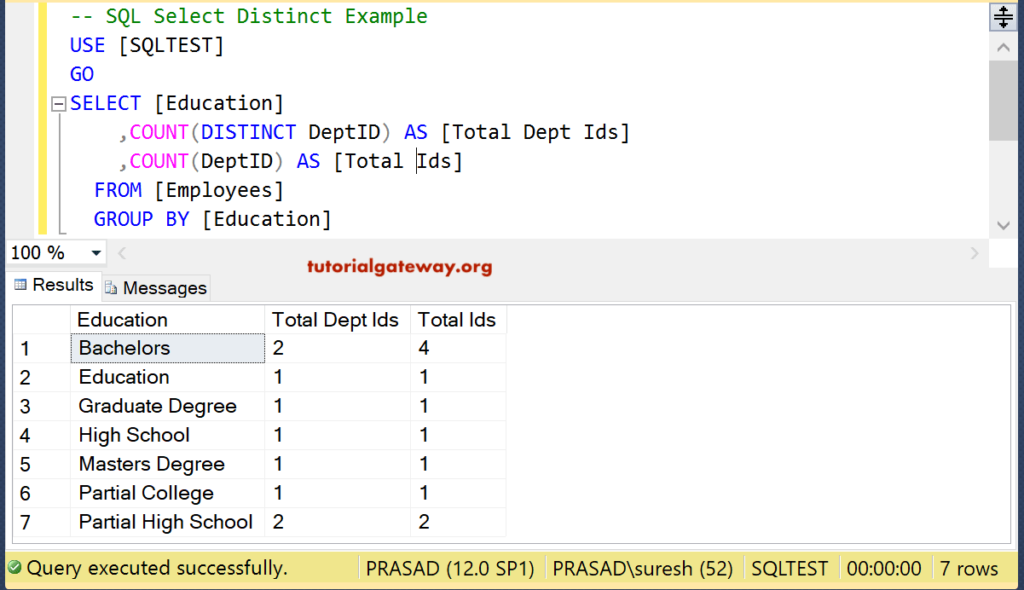
Sometimes, you may want to get only distinct values in a specified column of a table. UNIQUE is keyword for adding unique constraint on the column. We can use the SQL Server DISTINCT clause to return a single field that removes the duplicates from the result set. SELECT DISTINCT and SELECT UNIQUE behave the same way.
APPLIES TO: SQL Server Azure SQL Database Azure Synapse Analytics ( SQL DW) Parallel Data Warehouse Specifies the columns to be returned by the query. The SELECT UNIQUE construct is an Oracle-only SQL statement. The UNIQUE constraint ensures that all values in a column are different. Both the UNIQUE and PRIMARY KEY constraints provide a guarantee for uniqueness for a column or set of columns.
A PRIMARY KEY constraint automatically has a UNIQUE constraint. Create Unique Constraints. Your table may contain duplicate values in a column and in certain scenarios you may require fetching only unique records from the table. To remove the duplicate records for the data fetched with SELECT statement, you may use the DISTINCT clause as shown in the examples below.
If you have not understood what I am going to talk in this blog post by just reading the title, I think you are a normal human like me. Example - Finding Unique Values in Multiple Columns. Tablomuzda bir alandaki verilerin tekrarlı olmasını istemiyorsak UNIQUE kriterini kullanmamız gerekir. Tablo tasarımını yaparken bir alanın UNIQUE olup olmayacağına iyi karar vermemiz gerekir.
ALTER komutu ile alanın özelliklerini değiştirirken, ilgili alanda tekrarlayan kayıtlar varsa UNIQUE değerini veremeyiz. Find Duplicates From a Table in SQL Server Summary : in this tutorial, you will learn how to use the GROUP BY clause or ROW_NUMBER() function to find duplicate values in a table. Technically, you use the UNIQUE constraints to enforce the uniqueness of rows in one or more columns of a table. Use the SQL DISTINCT clause to return a unique list of values from a SQL SELECT statement. With DISTINCT, you elect to return unique values based on a combination of one or more columns.
The DISTINCT clause is used with the SELECT statement. It is placed immediately after SELECT and before the columns you wish to select. In the various tests, I have done in the past converting existing nonclustered index a unique nonclustered index always helped with the performance. However, SQL Server is a huge world and it is totally possible that I have not come across the scenario where unique nonclustered indexes are slower.
Thanks and Regards, Bharath S. Summary: in this tutorial, you will learn how to use the MySQL DISTINCT clause in the SELECT statement to eliminate duplicate rows in a result set. Introduction to MySQL DISTINCT clause. When querying data from a table, you may get duplicate rows. In order to remove these duplicate rows, you use the DISTINCT clause in the SELECT statement. List all Constraints of Database or Table Many times when we are using DML commands like: INSERT, UPDATE, DELETE, we get errors because one or the other constraint is set on the table.

It get really annoying when we are new to a Database and don’t know what constraints are set on the tables. Updated Microsoft Access to SQL Server Upsizing Center with whitepapers, resources, and SQL Server Express Downloads. Name, SchemaName = schema_name (schema_id), TableName = object_name (o. object_id) FROM sys. How to find unique indexes in a database?
Identify Duplicate Rows in a SQL Server Table. Removing duplicate values from table with a unique index is a bit easier than removing the rows from a table without it. Actually, there is no difference between DISTINCT and UNIQUE.
After that oracle also added DISTINCT but did not withdraw the service of UNIQUE keyword for the sake of backward compatibility. This article explains the SQL NOT NULL, Unique and SQL Primary Key constraints in SQL Server with examples. Constraints in SQL Server are predefined rules and restrictions that are enforced in a single column or multiple columns, regarding the values allowed in the columns, to maintain the integrity, accuracy, and reliability of that column’s data.
Hiç yorum yok:
Yorum Gönder
Not: Yalnızca bu blogun üyesi yorum gönderebilir.